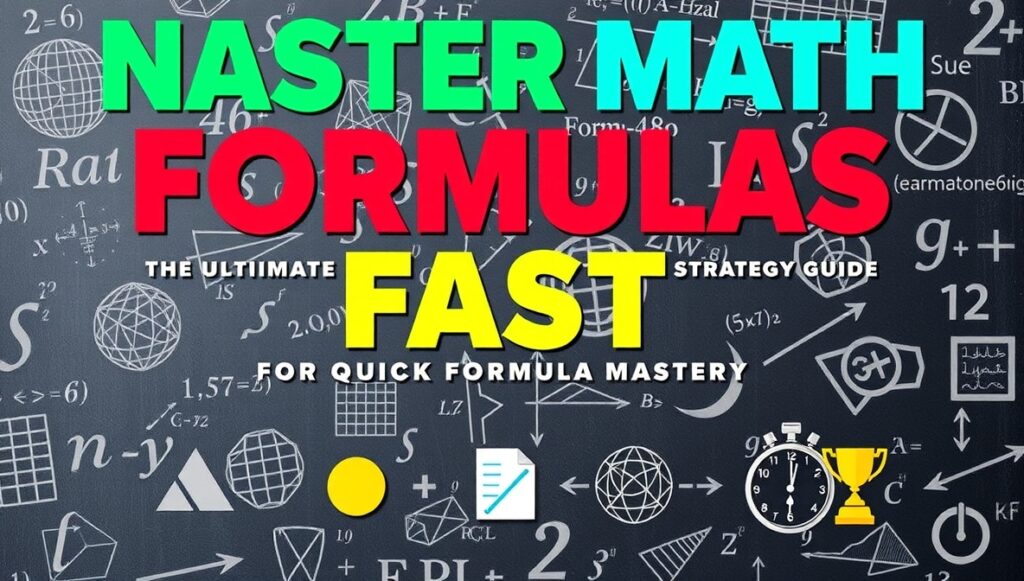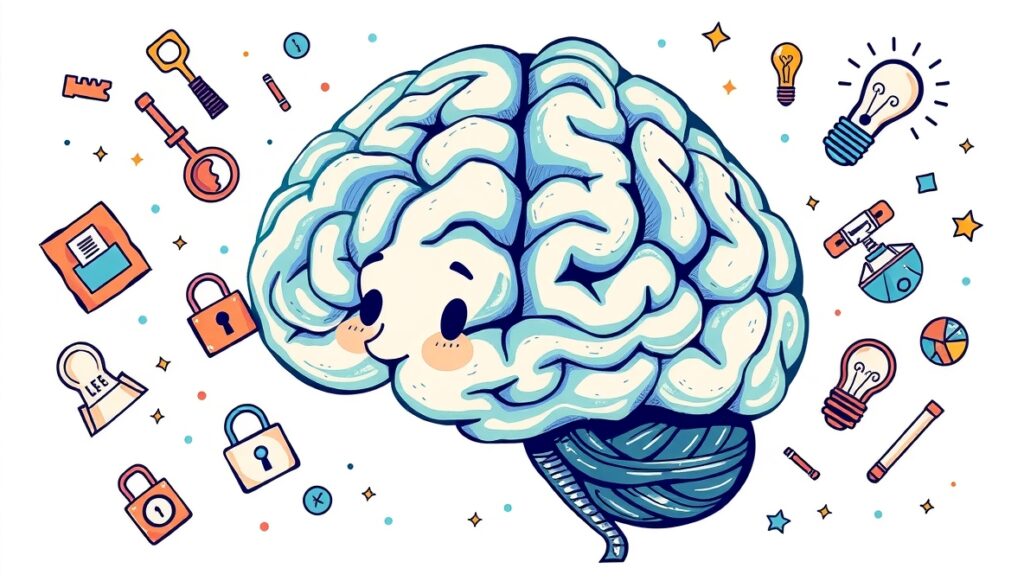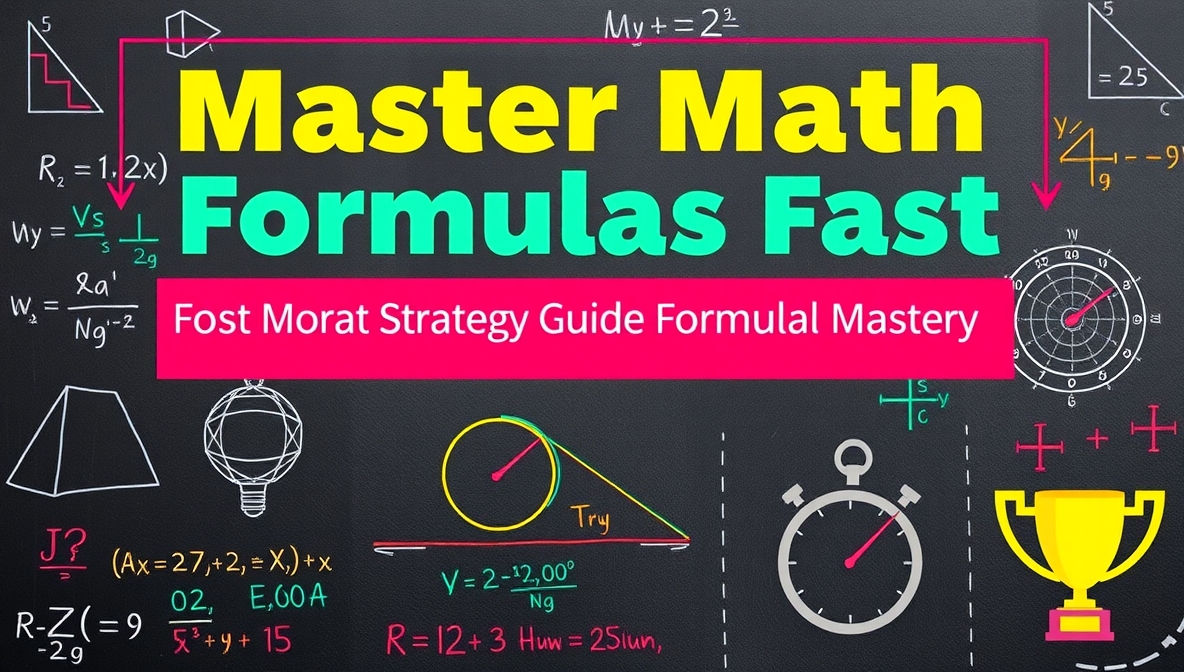Mathematics can feel overwhelming when you’re staring at pages of complex formulas, wondering how you’ll ever memorize them all. Whether you’re preparing for an exam, tackling a new math course, or simply trying to brush up on your skills, learning math formulas quickly and effectively is a challenge many students face. The good news is that with the right strategies, you can transform formula learning from a tedious memorization task into an engaging, efficient process that actually sticks.

The key to mastering math formulas isn’t just about rote memorization—it’s about understanding patterns, creating meaningful connections, and using scientifically-backed learning techniques that work with your brain’s natural processes. In this comprehensive guide, we’ll explore proven strategies that will help you learn math formulas faster, remember them longer, and apply them with confidence.
Understanding Before Memorizing: The Foundation of Formula Mastery
The biggest mistake students make when learning math formulas is jumping straight into memorization without understanding what the formula actually represents. This approach is like trying to memorize a foreign language without knowing what the words mean—you might succeed temporarily, but you’ll struggle to apply the knowledge meaningfully.
Before attempting to memorize any formula, invest time in understanding its purpose and derivation. Ask yourself: What problem does this formula solve? Where does it come from? How do the variables relate to each other? For example, instead of simply memorizing the quadratic formula, understand that it’s a tool for finding the roots of quadratic equations, derived from completing the square method.
When you understand the underlying concepts, formulas become logical rather than arbitrary. This understanding creates a strong foundation that makes memorization easier and retention longer-lasting. It also helps you recognize when and how to apply formulas in different contexts, which is crucial for problem-solving success.
The Power of Visual Learning: Making Formulas Memorable
Visual learning techniques can dramatically accelerate formula acquisition. Your brain processes visual information much faster than text, and visual memories tend to be more durable than purely verbal ones. Transform abstract formulas into visual representations that make sense to you.
Create visual associations for each component of a formula. For instance, when learning the area formula for a circle (A = πr²), visualize a pizza cut into small squares, with π representing the ratio that accounts for the circular shape. Draw diagrams that show how variables in a formula relate to geometric shapes or real-world objects.
Color-coding is another powerful visual technique. Assign different colors to different types of terms in formulas—use red for variables, blue for constants, and green for operations. This visual categorization helps your brain process and recall formulas more efficiently. When you see a formula, the color patterns will trigger faster recognition and recall.
Mind maps are particularly effective for organizing related formulas. Create a central concept and branch out to show how different formulas connect. This visual network helps you see the bigger picture and makes individual formulas easier to remember as part of a larger system rather than isolated facts.
Active Practice: The Difference Between Recognition and Recall
Recognition is passive—you can identify a formula when you see it. Recall is active—you can reproduce the formula from memory when needed. Most students focus on recognition, but exams and real-world applications require recall. Active practice techniques bridge this gap effectively.
Start with the “write-from-memory” method. After studying a formula, close your notes and write it out completely from memory. Don’t just think about it—physically write it. The act of writing engages motor memory, creating additional neural pathways that strengthen recall. If you can’t write the complete formula, identify which parts you missed and focus additional study time on those components.
Practice deriving formulas when possible. While memorization is important, understanding how to derive a formula provides a backup method when memory fails. Many mathematical formulas follow logical steps that, once understood, can be reconstructed even if you forget the final form. This approach is particularly valuable for complex formulas in calculus, physics, and advanced mathematics.
Implement spaced repetition in your practice schedule. Review new formulas after one hour, then after one day, then after three days, then after a week. This scientifically-proven technique takes advantage of your brain’s natural forgetting curve, strengthening memories just as they begin to fade.
Creating Meaningful Connections: The Web of Mathematical Knowledge
Isolated facts are harder to remember than connected information. Build a web of connections between formulas, concepts, and applications. When you learn a new formula, actively look for connections to formulas you already know.
Many mathematical formulas share common patterns or structures. Recognize these patterns to accelerate learning. For example, many area formulas involve multiplying length measurements, and many physics formulas follow the pattern of rate times time equals distance. When you identify these patterns, new formulas become variations on familiar themes rather than completely new information.
Create formula families by grouping related equations. Organize trigonometric identities together, group all area formulas, or collect formulas related to a specific mathematical concept like derivatives or logarithms. This organization helps you see relationships and makes it easier to recall the right formula for specific situations.
Connect formulas to real-world applications whenever possible. Abstract mathematical concepts become more memorable when tied to concrete examples. The compound interest formula becomes more meaningful when you think about actual savings accounts. Physics formulas gain relevance when connected to real phenomena you can observe.
Mnemonic Devices and Memory Tricks: Making the Abstract Concrete
Mnemonic devices transform abstract formulas into memorable stories, acronyms, or phrases. While not every formula lends itself to mnemonics, creative memory aids can be incredibly effective for particularly challenging equations.
Create acronyms for the order of operations or the sequence of variables in complex formulas. For the quadratic formula, some students remember “negative B, plus or minus the square root of B squared minus 4AC, all over 2A” as a rhythm or song. The musicality makes it more memorable than the mathematical notation alone.

Story-based mnemonics work well for formulas with multiple variables. Create a brief story that incorporates all the elements of a formula in the correct order. The more vivid and unusual the story, the more memorable it becomes. Your brain naturally remembers stories better than abstract symbols.
Use the “chunking” technique to break complex formulas into smaller, manageable pieces. Instead of trying to memorize a long formula as one unit, divide it into logical chunks and learn each piece separately before combining them. This approach reduces cognitive load and makes complex formulas less intimidating.
Technology and Tools: Leveraging Digital Resources for Formula Mastery
Modern technology offers powerful tools for formula learning that weren’t available to previous generations of students. Digital flashcards with spaced repetition algorithms can optimize your review schedule automatically. Apps like Anki or Quizlet allow you to create custom formula decks and track your progress over time.
Interactive graphing tools help visualize how formulas behave with different input values. When you can see how changing variables affects the output of a formula, you develop a deeper understanding that supports memorization. Tools like Desmos or GeoGebra make abstract mathematical relationships concrete and observable.
Video resources can provide multiple perspectives on formula derivation and application. Sometimes a different explanation or visual approach will make a formula click in ways that textbook presentations don’t. Use video resources to supplement, not replace, your primary learning materials.
Consider using math notation software to practice writing formulas digitally. Tools like LaTeX or MathType help you become comfortable with proper mathematical notation while reinforcing formula structures through the act of typing them correctly.
Common Pitfalls and How to Avoid Them
Many students fall into predictable traps when learning math formulas. Recognizing these pitfalls helps you avoid wasted effort and frustration. The most common mistake is passive reading—simply looking at formulas repeatedly without active engagement. Reading is not learning. You must actively work with formulas to master them.
Another common error is studying formulas in isolation from their applications. Formulas without context are meaningless symbols. Always study formulas alongside example problems that demonstrate their use. This contextual learning makes formulas more memorable and useful.
Don’t rely solely on understanding or solely on memorization. Both are necessary for true mastery. Understanding without memorization leaves you unable to access knowledge quickly when needed. Memorization without understanding leads to errors and inability to adapt to new situations.
Avoid the “illusion of knowing” that comes from recognition without recall. Just because you recognize a formula when you see it doesn’t mean you can reproduce it when needed. Test your actual recall ability regularly, not just your recognition.
Building Long-Term Retention: Beyond the Exam
The ultimate goal isn’t just to pass the next test, but to build lasting mathematical knowledge you can draw upon throughout your academic and professional career. Long-term retention requires different strategies than short-term cramming.
Regular review is essential for maintaining formula knowledge over time. Schedule periodic review sessions even after you’ve initially mastered formulas. Mathematical knowledge builds upon itself, so maintaining access to foundational formulas supports learning more advanced concepts later.
Apply formulas in varied contexts to strengthen retention. Don’t just practice the same types of problems repeatedly. Seek out applications in different mathematical areas, word problems with different contexts, and problems that require combining multiple formulas.
Teach formulas to others when opportunities arise. Explaining mathematical concepts to someone else reveals gaps in your understanding and reinforces your knowledge. The act of teaching forces you to organize information clearly and identify the most important aspects of what you’ve learned.
Measuring Progress and Adjusting Strategy
Effective learning requires ongoing assessment and strategy adjustment. Create regular checkpoints to evaluate your formula mastery objectively. Time yourself writing formulas from memory. Track which formulas you consistently remember and which ones require additional work.

Keep a “formula error log” where you record mistakes you make during practice problems. Analyze these errors to identify patterns. Are you consistently confusing similar formulas? Are you making sign errors? Are you forgetting specific components? This analysis helps you focus your study efforts where they’re needed most.
Be willing to adjust your learning strategies based on what works for you. Not every technique will be equally effective for every person or every type of formula. Experiment with different approaches and focus your effort on the methods that produce the best results for your learning style.
Conclusion: Your Path to Formula Mastery
Learning math formulas quickly and effectively is a skill that improves with practice and the right strategies. By combining understanding with memorization, using visual learning techniques, practicing active recall, creating meaningful connections, employing memory aids, leveraging technology, avoiding common pitfalls, focusing on long-term retention, and regularly assessing your progress, you can transform formula learning from a frustrating chore into an efficient, even enjoyable process.
Remember that mastering math formulas is not just about memorization—it’s about building a toolkit of mathematical knowledge that you can apply flexibly and confidently. The investment you make in developing effective formula learning strategies will pay dividends throughout your mathematical journey, making advanced topics more accessible and problem-solving more intuitive.
Start implementing these strategies with your current mathematical studies. Begin with the techniques that seem most applicable to your situation and gradually incorporate others as you build confidence and skill. With consistent practice and the right approach, you’ll find that math formulas become not just memorized facts, but integrated knowledge that enhances your mathematical thinking and problem-solving abilities.



